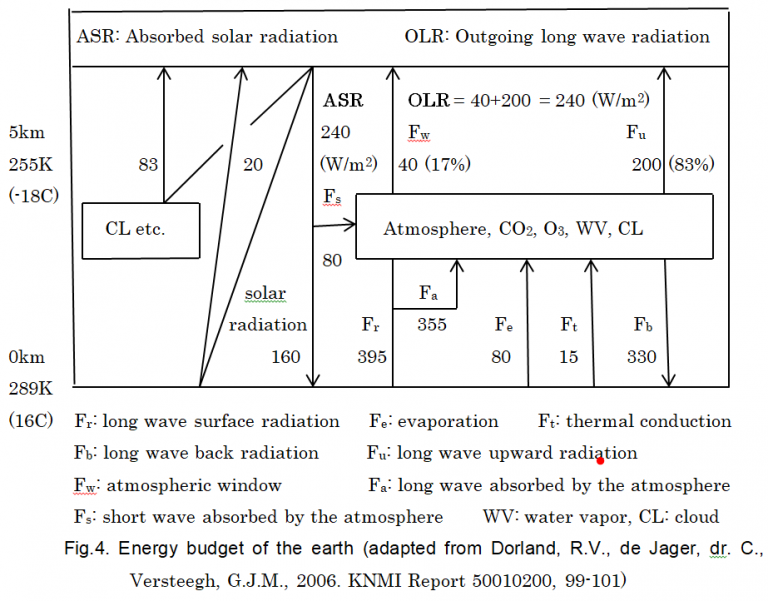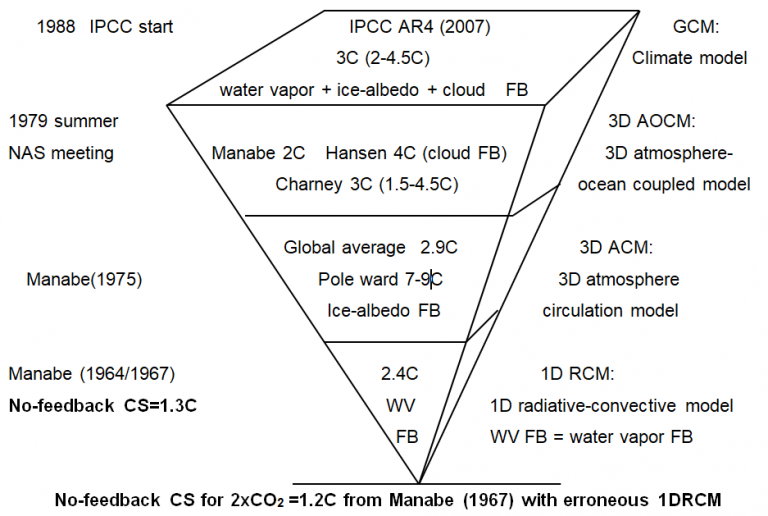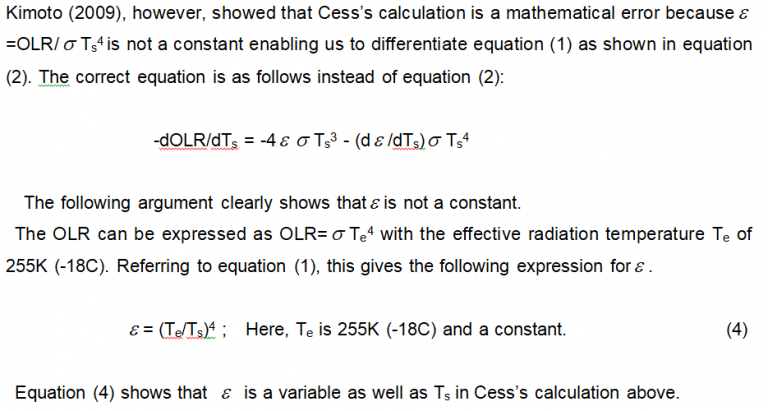History of the AGW narrative of the IPCC
Kyoji Kimoto, kyoji@mirane.co.jp
Independent climate researcher
Manabe’s model studies debunked by Newell (1979)
The anthropogenic global warming (AGW) scare was created in part by Japanese scientist Syukuro Manabe using a one dimensional radiative-convective model (1DRCM) having no ocean (1964/1967). He obtained a no-feedback climate sensitivity of 1.3°C for doubling of CO2 using the fixed lapse rate assumption of 6.5°C/km and a radiative forcing of 4(W/m2) at the tropopause, which was further enlarged to 2.4°C with a water vapor feedback.
Eminent meteorologist R. Newell from MIT criticized Manabe’s model lacking in ocean cooling. He obtained a No-feedback climate sensitivity of 0.03°C for a doubling of CO2 with a thermal inertia of 30 (W/m2) per 1°C for the surface waters of the ocean using a surface radiative forcing of 1(W/m2) to incorporate the IR spectra overlap between CO2 and water vapor.
Syukuro Manabe
The department of Energy & Dr. R. Cess, however, killed Newell’s ideas to promote nuclear reactors in a difficult time due to the Three Mile Island nuclear accident in 1979.
Manabe continued his model studies to enlarge climate sensitivity (CS) for a doubling of CO2 with introducing various feed backs (FBs) as follows, which is the theoretical basis of IPCC’s AGW narrative.
Fig. 1 History of the CS for 2xCO2 with model studies by Manabe & IPCC
Cess’s erroneous calculation of the Planck feedback parameter
Cess (1976, 1989) expressed the outgoing long wave radiation (OLR) with equation (1) based on the old energy budget of the earth as shown by Fig. 2.
He obtained a Planck feedback parameter0 of -3.3(W/m2)/C with equation (2), giving a No-feedback CS of 1.2°C using a radiative forcing of 4W/m2 for a doubling of CO2 at the tropopause as follows:
Cess’s Planck feedback parameter is used in all GCMs for the IPCC ARs with a slight decrease of the radiative forcing from 4 (W/m2) to 3.7 (W/m2) for a doubling of CO2 by IPCC TAR (2000).
Fig. 3 Feedback parameters of 14 GCMs for the IPCC AR4 by Soden (2006)
Cess’s equation (1) is physically wrong
Cess did not know the atmospheric window because he was caught by the old energy budget of the earth (see Fig.2).
The OLR is expressed by equation (5) based on a modern energy budget of the earth as shown by Fig.4
OLR= Fu (Tu) (83%) + Fw (Ts) (17%) (5)
Equation (5) means the upper troposphere temperature Tu is increased as much as ~1°C with CO2 doubling instead of the surface temperature Ts.

Comparison of no-feedback climate sensitivities
The following list shows the no-feedback climate sensitivities for a doubling of CO2 in the literature:
- Ramanathan (1979) 0.2°C based on the Stefan-Boltzmann law
- Newell (1979) 0.03°C based on the ocean thermal inertia of 30 (W/m2)/C
- Idso (1980) less than 0.26°C based on the natural experiments
- Ramanathan (1981) 0.17°C based on the Stefan-Boltzmann law
- Idso (1998) 0.1°C based on the 10 natural experiments
- Kimoto (2015) 0.15°C based on the Stefan-Boltzmann law
- Manabe (1964/1967) 1.3°C based on the 1DRCM having no ocean
- Cess (1976) 1.2°C based on a calculation with a mathematical error
- Hansen (1981) 1.2°C based on Manabe’s 1DRCM
- Schlesinger (1986) 1.3°C based on Manabe’s 1DRCM
- Schlesinger (1986) 1.2°C with a trick concealing Cess’s mathematical error
Conclusion
All green policy is nonsense because it depends on IPCC’s claim that the surface temperature Ts is increased as much as 3°C for CO2 doubling utilizing an erroneous Plank feedback parameter0 of -3.21(W/m2)/C from Cess’s mathematical error.
The Paris climate agreement reads as follows: “To keep the rise in mean global temperature to well below 2°C above pre-industrial levels, and preferably limit the increase to 1.5°C.”
This is based on IPCC’s erroneous climate sensitivity of 3°C for doubling of CO2 discussed above. Therefore the Paris climate agreement is nonsense, though it governs the world politics now.
(References)
Cess, R.D., An appraisal of atmospheric feedback mechanisms employing zonal climatology, J. Atmospheric Sciences, 1976, 33, 1831-1843.
Cess, R.D., Potter, G.L., Blanchet, J.P., Boer, G.J., Ghan, S.J., Kiehl, J.T., Le Treut, H., Li, Z.X., Liang, X.Z., Mitchell, J.F.B., Morcrette, J.J., Randall, D.A., Riches, M.R., Roeckner, E., Schlese, U., Slingo, A., Taylor, K.E., Washington, W.M., Wetherald, R.T. and Yagai, I., Interpretation of cloud-climate feedback as produced by 14 atmospheric general circulation models, Science, 1989, 245, 513-516.
Hansen, J., Johnson, D., Lacis, A., Lebedeff, S., Lee, P., Rind, D. and Russell, G., Climate impact of increasing atmospheric carbon dioxide, Science 1981, 213, 957-966.
Idso, S. B., The climatological significance of a doubling of Earth’s atmospheric carbon dioxide concentration, Science 1980, 207,1462-1463.
Idso, S. B., CO2-induced global warming: a sceptic’s view of potential climate change,
Climate Research,1998, Vol.10, 69-82.
Kimoto, K., On the confusion of Planck feedback parameters, Energy & Environment, 2009, Vol.7, 1057-1066.
Kimoto, K., Will coal save Japan and the world?, Energy & Environment, 2015, 26, 1055~1067.
Manabe, S. and Strickler, R.F., Thermal equilibrium of the atmosphere with a convective adjustment, J. Atmospheric Sciences, 1964, 21, 361~385.
Manabe, S. and Wetherald, R.T., Thermal equilibrium of the atmosphere with a given distribution of relative humidity, J. Atmospheric Sciences, 1967, 24, 241-259.
Manabe, S and Wetherald, R.T., The effects of doubling the CO2 concentration on the climate of a general circulation model, J. Atmospheric Sciences, 1975, 32, 3~15.
Newell, R.E. and Dopplick, T.G., Questions concerning the possible influence of anthropogenic CO2 on atmospheric temperature, J. Applied Meteorology, 1979, 18, 822-825.
Ramanathan, V., et al., J. Geophysical Research, 84, 4949-4958 (1979)
Ramanathan, V., The role of ocean-atmosphere interactions in the CO2 climate problem, J. Atmospheric Sciences, 1981, 38, 918-930.
Ramanathan, V., The role of earth radiation budget studies in climate and general circulation research, J. Geophysical Research,1987, 92, 4075-4095.
Schlesinger, M.E., Equilibrium and transient climatic warming induced by increased atmospheric CO2, Climate Dynamics, 1986, 1, 35-51.
Soden, B.J. and Held, I.M., An assessment of climate feedbacks in coupled ocean-atmosphere models. J. Climate, 2006, 19, 3354-3360.











The main problem with these energy budget and all these GHG “theories” is that there is always a confusion between radiatives fluxes and energy transfers :
– Fa and Fb are radiative fluxes not energy transfers.
– The radiative energy transfer between the surface and the atmosphere is Fa – Fb = 25 W/m². This radiative transfer is upward : radiatively, the surface warms the atmosphere (not the opposite).
So the active gases in the IR spectrum (CO2, WV, …) actually absorb the energy Fa – Fb = 25 W/m² (NOT Fa = 355 W/m² which is a flux) and they transfer Fu – 0 = 200 W/m² into space according to the Earth Energy Budget Fig. 4. The energy/heat transfer between those 2 radiative transfers is done by upward radiative transfer and convection of warm air and advection of cold air.
Thus those gases DO NOT warm the atmosphere, actually, they cool it by 200 – 25 = 175 W/m².
Yong Tuition has a few youtubes discussing Manabe’s work. Very enlightening
Manabe was wrong for many reasons, and they are not discussed here. Anyway, the atmospheric window is still another innuendo. A 40W/m2 was suggested by Kiehl/Trenberth. But since then Trenberth corrected it to only 22W/m2. Both figures are wrong and baseless.
Realistically it is in the 65-70W/m2 range, and that is a conservative guesstimate.
https://greenhousedefect.com/the-holy-grail-of-ecs/seeing-through-the-atmospheric-window
[…] Fonte : No Tricks Zone […]
I get the gist of this, namely the IR passing through the atmospheric window is impervious to the amount of GHGs in the atmosphere, and thus should not be included in the “forcing.”
However, given this revelation, a correct “Plank feedback factor” should be specified and thus a correct climate sensitivity calculated. I didn’t see this in the paper. Calling the IPCC value nonsense was rather a pathetic conclusion. Furthermore, this idea of radiative forcing at the tropopause has always been unclear to me. It cannot mean that the temperature at the tropopause goes up, because that would perforce mean the outgoing IR to space would go up, which means the earth would get cooler (radiating more IR cools the planet). What it seems to mean is that the effective altitude of IR emissions goes higher (which means “cooler” in the tropopause), and through some inexplicable process lower levels of air much heat up to “force” the requisite 240W/M2 to outer space.
This latter claim has never been verified to my knowledge and seems to be a matter of faith. But I could equally assert that more CO2 molecules in the troposphere (including the air near the tropopause) would radiate more because they reduce the specific heat of the air mixture, thereby offsetting all or some of this forcing due to a higher effective emission altitude.
In any event it is just incorrect to say that 2X CO2 increases the temperature at the tropopause presuming this is a specific location (i.e., doesn’t move).
Correction to the previous post: “cooler in the tropopause” should be “cooler in the troposphere” or “temperature at the tropopause,” because of course the temperature IN the tropopause is constant with altitude. This brings up another point, namely if 2x CO2 AT (as in NEA) the tropopause happens, it doesn’t get cooler with altitude and if you break through to the stratosphere, then temps go up with altitude. The presumed way out of this dilemma is that more CO2 in the upper troposphere “pushes” the location of the tropopause higher. Of course it would be nice for there to be some observational confirmation of this.
Correction to the previous post: “cooler in the tropopause” should be “cooler in the troposphere” or “cooler until the tropopause,” because of course the temperature IN the tropopause is constant with altitude. This brings up another point, namely if 2x CO2 AT (as in NEAR) the tropopause happens, it doesn’t get cooler with altitude and if you break through to the stratosphere, then temps go up with altitude. So how does 2X CO2 increase the temps near the tropopause 1C and not push the effective emission altitude into the tropopause? The presumed way out of this dilemma is that more CO2 in the upper troposphere “pushes” the location of the tropopause itself higher. Of course it would be nice for there to be some observational confirmation of this.
[…] From NoTricksZone […]
[…] Fonte : No Tricks Zone […]
It doesn’t matter if all the IPCC assumptions or models are wrong.
what is important for politicians is that electors believe them.
Electors believe them because we have seen some warm years.
I have a friend who tells me continuously: has or hasn’t weather become warmer in the last 50 years? Why when I was a child there was snow and now there is not?
and such things.
why should politicians change their politics if they can keep their chairs (and salaries) going on with this one?
“why should politicians change their politics if they can keep their chairs (and salaries) going on with this one?”
Politicians love money AND control; the topic, climate, war, plandemic is irrelevant.
[…] *** Japanese Scientist Concludes IPCC Is Using “Erroneous” Parameters And Climate Sensitivities […]
[…] CO2 Has Zero Impact on Climate Change*** Polar Bears, Dead Coral and Other Climate Fictions*** Japanese Scientist Concludes IPCC Is Using “Erroneous” Parameters And Climate Sensitivities*** Inconvenient Truth: 32 Climate Predictions Proven […]